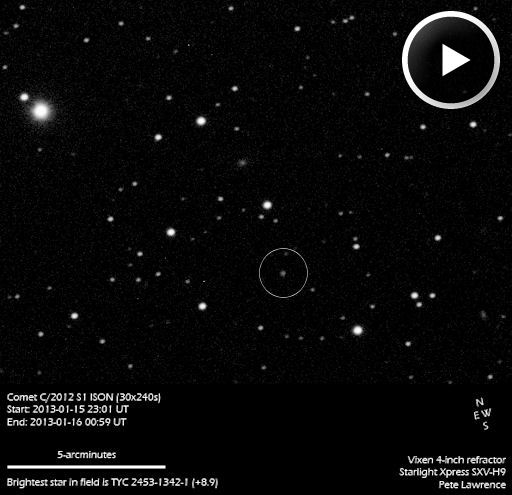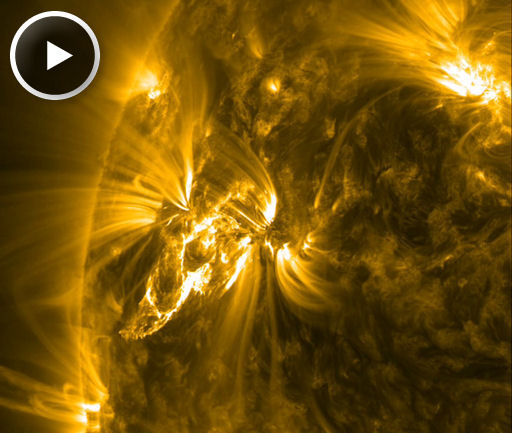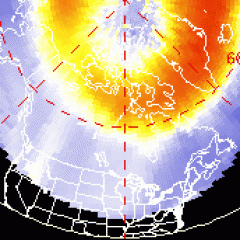CHANCE OF STORMS: NOAA forecasters estimate a 30% chance of polar geomagnetic storms today. The reason is an incoming CME, which could deliver a minor blow to Earth's magnetic field during the next 24 hours. Arctic sky watchers should be alert for auroras. Aurora alerts: text, voice.
Even before the CME arrives, Arctic skies are glowing. Göran Strand sends this picture, taken on Jan. 17th, from Kall, Åre, Sweden:
"Two friends and I went out last night to capture the aurora that was forecast," says Strand. "It turned out to be a fantastic night with a half moon lighting up the landscape in a lovely way. In the distance you can the mountain Åreskutan, the biggest ski resort in Sweden."
COMET OF THE CENTURY? Later this year, Comet ISON could become bright enough to see in broad daylight when it passes through the atmosphere of the sun. At the moment, however, it is a cold and lonely speck barely visible through backyard telescopes. Two nights ago, Pete Lawrence of Selsey, UK, photographed the potentially-great comet moving through space near the orbit of Jupiter:
"I created this animation using images taken through a 4-inch refractor, starting at 23h on the 15th of January and ending at 01h on the 16th," says Lawrence. "The comet is clearly visible moving among the stars of Gemini, in an area just to the south of Castor."
Comet ISON looks so puny now because it is more than 600 million km away. In late 2013, however, it will be much closer. A key date is Nov. 28th when Comet ISON flies through the solar corona only 1.2 million km from the surface of the sun. If the comet survives the encounter--a big IF--it could emerge glowing as brightly as the Moon with a sensational tail sure to create a worldwide sensation. Stay tuned!
RESTLESS SUNSPOT: The magnetic canopy of sunspot AR1654 is in a state of unrest, relentlessly shifting, reconnecting, and crackling with minor flares. This movie from NASA's Solar Dynamics Observatory shows six days (Jan. 9-15) of action:
The sunspot's magnetic field, illuminated above by the extreme UV glow of hot plasma and flares, has a 'beta-gamma-delta' configuration. That means it harbors energy for powerful X-class eruptions. So far, however, the sunspot has failed to produce a major eruption. Perhaps the tension is being relieved prematurely by restless fidgeting. NOAA forecasters estimate a 5% chance of X-flares during the next 24 hours. Solar flare alerts: text, voice.

![]()
Solar wind
speed: 452.8 km/sec
density: 18.3 protons/cm3
explanation | more data
Updated: Today at 1716 UT
![]()
X-ray Solar Flares
6-hr max: C1 1314 UT Jan18
24-hr: C2 0943 UT Jan18
explanation | more data
Updated: Today at: 1700 UT
![]()
![]()
![]()
Daily Sun: 18 Jan 13
![]()
![]()
Decaying sunspot AR1654 has a beta-gamma magnetic field that harbors energy for M-class solar flares. Credit: SDO/HMI
![]()
![]()
![]()
Sunspot number: 74
What is the sunspot number?
Updated 18 Jan 2013
Spotless Days
Current Stretch: 0 days
2013 total: 0 days (0%)
2012 total: 0 days (0%)
2011 total: 2 days (<1%)
2010 total: 51 days (14%)
2009 total: 260 days (71%)
Since 2004: 821 days
Typical Solar Min: 486 days
Update 18 Jan 2013
The Radio Sun
10.7 cm flux: 123 sfu
explanation | more data
Updated 18 Jan 2013
![]()
![]()
![]()
Current Auroral Oval:
![]()
Switch to: Europe, USA, New Zealand, Antarctica
Credit: NOAA/POES
![]()
![]()
![]()
Planetary K-index
Now: Kp= 3 quiet
24-hr max: Kp= 3 quiet
explanation | more data
![]()
Interplanetary Mag. Field
Btotal: 4.9 nT
Bz: 4.2 nT north
explanation | more data
Updated: Today at 1716 UT
![]()
![]()
![]()
Coronal Holes: 18 Jan 13
![]()
![]()
There are no large coronal holes on the Earthside of the sun. Credit: SDO/AIA.







